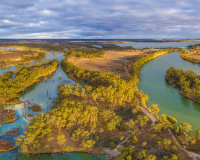
Planning a Tiny Home in South Australia? Here’s When You Need Approval
Your Guide to Tiny Home Planning and Approvals in South Australia. (Updated July 2025)
Tiny homes have become incredibly popular in the past decade, but in South Australia, the rules around them can be confusing. Councils and other authorities often treat tiny homes differently, and there’s no consistent approach across the state. That means it can be hard to know whether you need planning approval or not.
Unfortunately, many tiny home companies, especially those selling pre-fabricated homes built interstate or overseas, may not fully explain the rules. You could end up buying an expensive unit that you can’t legally use. So before you commit, read this guide to understand when approvals may be needed and how to avoid costly mistakes.

Do I Need Planning Consent for a Tiny Home?
If you’re placing a single tiny home on wheels on your land and already live on the same property, your tiny home might be treated like a caravan under South Australian legislation. This means you may be able to use the tiny home as a caravan on your land as long as the tiny home is:
-
Registered as a caravan, and
-
Not used as a permanent home or for tourist accommodation, and
-
Not connected to permanent services (like plumbing or sewerage).
But if the tiny home is lived in full-time, rented out, or connected to a waste system, it usually won’t qualify as a caravan. In that case, a development application may be required, and the Council may treat it as a permanent building.
Can I Put a Tiny Home on Vacant Land?
Generally, yes, but you’ll need approval. A tiny home on vacant land is not “associated” with an existing house, so it’s usually considered a new dwelling or tourist accommodation. This means:
-
You’ll need planning consent, and possibly building approval too.
-
You might avoid this if the tiny home is only used temporarily, like a caravan towed in and out for short stays. But if it stays in place for more than a couple of days at a time, approval will likely be needed.
What If I Want to Connect It to Plumbing?
Most Councils will say that once your tiny home is connected to a wastewater system, it can no longer qualify as a caravan. This triggers the need for:
-
Planning consent, and
-
Wastewater system approval under the South Australian Public Health (Wastewater) Regulations 2012, and
-
Likely a Building Rules Consent (BRC) too.
Can I List My Tiny Home on Airbnb or Similar Sites?
Renting out your tiny home short-term (e.g. Airbnb) doesn’t automatically mean you need approval, but it can change how your use is classified.
Often, Councils may consider the property a caravan park or tourist accommodation, which requires:
-
A planning application, and
-
More detailed documents and plans.
So if you’re planning to earn income from your tiny home, you’ll likely need consent.
What is Building Rules Consent (BRC) and Why Does It Matter?
BRC is a key part of development approval that checks your structure meets safety and construction standards under the National Construction Code.
More and more, Councils are treating tiny homes used as permanent dwellings or holiday rentals as buildings, meaning:
-
A full building assessment is required, and
-
Your tiny home must meet requirements for minimum ceiling heights, bushfire safety, and more.
This can be a real challenge for prefabricated tiny homes, especially those built interstate or overseas. In some cases, significant upgrades are needed, or approval may be refused entirely.
Still not sure?
If you’re thinking about buying or placing a tiny home, don’t guess, get expert advice.
At Certified Planning and Development (CPD), we offer a free initial consultation to help you understand what approvals you may need and the best steps to take. We can:
-
Speak with Council on your behalf,
-
Prepare plans and documents,
-
Manage your applications from start to finish.
In many cases, we’ve found that a permanent building, like a granny flat, is a more suitable and still a cost-effective option. You can explore those options further on our website.
To follow along and find out more about planning issues, hear client stories or learn more about the development process make sure to read our online stories and follow any of our social media channels to stay updated. We are waiting for your call for assistance on any project requiring a planning and development consultant.






